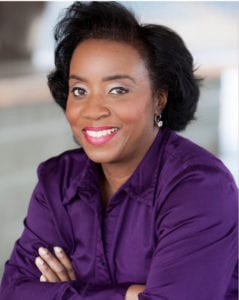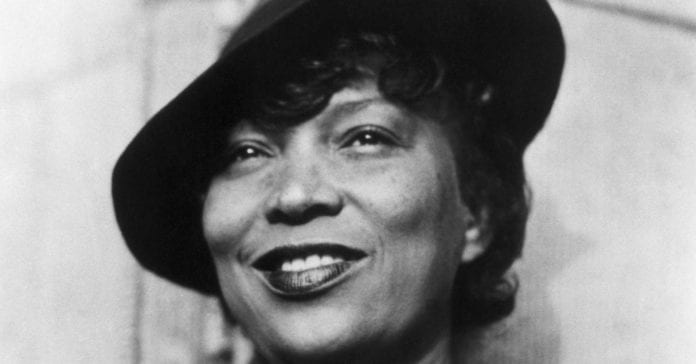When she was a struggling actress many years ago, Ann Perry Wallace dreamed of performing a one-woman play. This weekend, that dream will come true.

“I was a struggling, young actress working in Chicago at Roosevelt University in international admissions, typing forms all day to assist foreign students obtain visas. My supervisor gave me her copy of ‘Their Eyes Were Watching God’ in 1991. That was my introduction to Zora Neale Hurston. There are so many stories you could tell about her. I had to decide which stories to tell.”
Eighteen years later, Wallace gets her shot at a one-woman stage spectacle as Zora Neale Hurston in “Live Rich Die Poor” this weekend. The debut production will appear at the Voices of the South theatre on the campus of First Congregational Church.
Wallace is the writer, producer and star of the drama. Darius Wallace, her actor husband, is director.
The project is especially important for Wallace personally. As the mother of budding “singers and actresses,” Wallace said she wants her daughters to see her creating her own opportunity and not sitting around waiting for someone to give her an acting job. Wallace wanted the one-woman show on Hurston, and she had to make it happen if it was going to come to fruition.
“Zora Neale Hurston was a fascinating person,” said Wallace. “She had three husbands. In a quest to be a writer, she left the love of her life. In effect, writing was actually the love of her life. In one of those great moments on stage, she says, ‘I don’t do writing. I am writing.’ Zora Neale Hurston was driven by the stories that told themselves through her writing.”
Back in the late 1990s, Wallace attended the first Zora Neale Hurston Festival in Eatonville, Florida. Eatonville was the first incorporated African-American town in the country and the place where Hurston grew up. The experience proved invaluable in Wallace’s years of research into the life and works of Hurston.
“Hurston mentioned what she calls the ‘lost years,’ which I did not include in the play. Young Zora experienced early trauma when her mother died. Her father remarried and sent her off to boarding school. He never returned for her. My daughter went to camp for three weeks. That’s the longest she’s ever been away from home. My husband told me to imagine sending our daughter to camp, and she is waiting with her suitcase for us to come and get her. But we never come. That’s what Zora’s father did to her.”
Hurston, herself, says little about the “lost years.” After being sent off to boarding school and abandoned by her father, young Zora is shuffled between relatives. Not much else is known about her life during that time. When she resurfaces in 1917, Hurston is 26 years old, but has not finished high school. To take advantage of free public education in Baltimore, Maryland, she claims to be 16, and her birth year as 1901. It is a lie she perpetuates all throughout her life.
“We don’t really know what happened during the lost years,” said Wallace. “Maybe Zora was ashamed of some of the things she had to do to survive.”
Wallace wanted most of all to capture Hurston’s boldness of spirit. The author wanted to be free to do as she pleased — always.
Hurston was romantically linked to both men and women, just as other noted writers and artists were during the Harlem Renaissance.
“She was said to have had a crush on the singer Bessie Smith,” said Wallace. “The two have been linked, but whether something actually happened between them, I guess, we’ll never know. But the Harlem Renaissance in New York City was a very permissive time. The Negro was very much in vogue. They were famous, young, many enjoyed great financial benefit. They were free in a way they had never been before. Many lived a bisexual lifestyle, and some even an openly homosexual lifestyle.”
“Zora was married to a doctor, but she left,” said Wallace. “Being a homemaker for a doctor was just not what she wanted. She could have been a doctor’s wife, living in the lap of luxury, but Ms. Hurston rejected that life. But later, she had a white benefactor, Charlotte Mason Osgood, who was also Langston Hughes’ benefactor. They had to call her ‘Godmother’ and Ms. Osgood referred to herself as a ‘black god.’ Isn’t that crazy?”
Hurston did live well and enjoyed a thriving writing career. Ultimately, she was brought down, not by African-American critics of her work, but by accusations that she molested the 10-year-old son of a former landlord. She was arrested and jailed, but proven innocent when the boy and his two friends recanted the molestation stories.
“It was just too late,” said Wallace. “The black press had covered the story, and the damage had already been done to her reputation. She left New York and returned home to Florida. Her final years were impoverished, but she never stopped writing. She was doing research on King Herod of the Bible and still writing and calling publishers about her work. After two or three strokes, I think she realized that her writing skills had declined, and that her mental sharpness was gone.”
Hurston was buried in a pauper’s grave, having lived her last days in a St. Lucie, Florida, welfare home. She was 69.
“Live Rich Die Poor” showtime for Friday and Saturday is 7 p.m. Friday’s performance, said Wallace, is nearly sold out. On Sunday, the play is slated for 2:30 p.m.
For reservations and ticket information, visit brownpapertickets.com. Then, type in “Live Rich Die Poor.”




